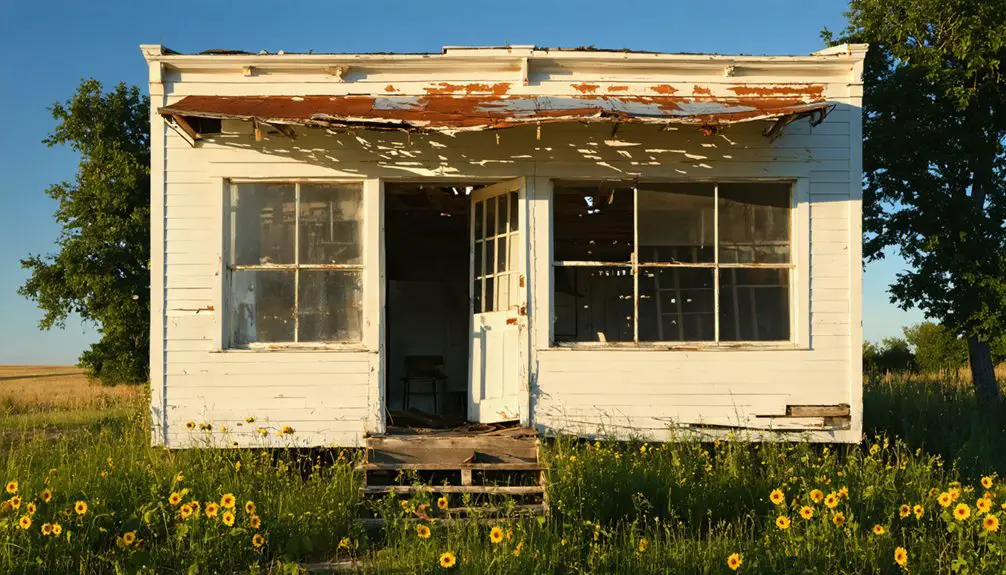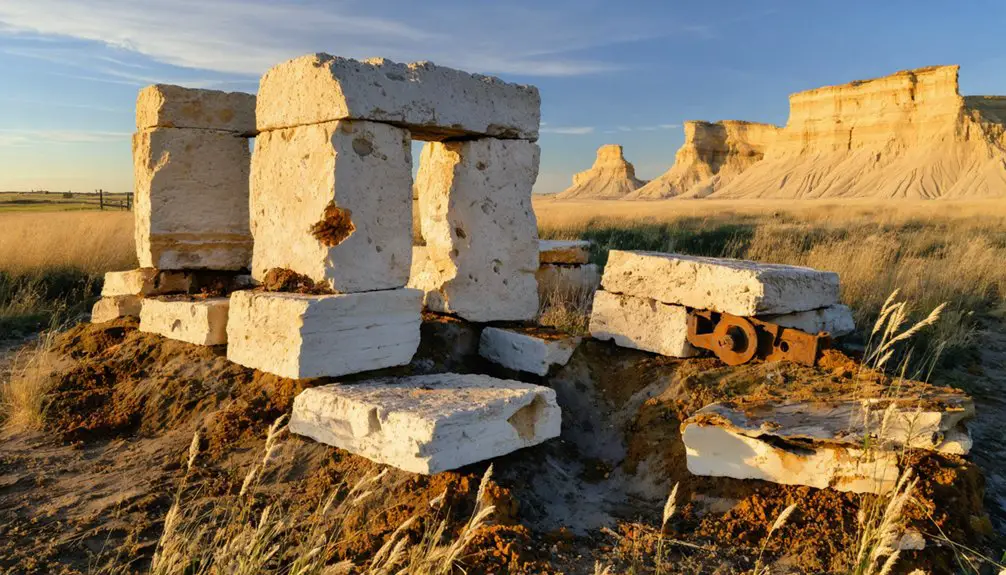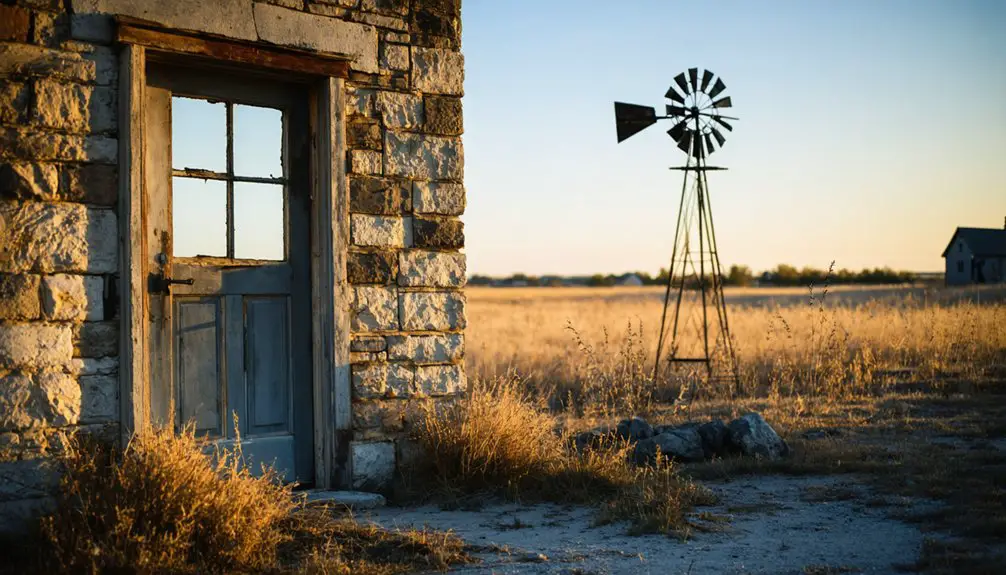You’ll find McAllaster in Logan County, Kansas, where it was established in 1887 along the Union Pacific Railroad at Mile Post 408. This ghost town‘s story mirrors many prairie settlements that rose and fell with changing times. Beyond its agricultural heritage, McAllaster Butte gained fame for its Pierre Shale formation and the discovery of Elasmosaurus platyurus fossils. Today, only one house remains standing, but the site holds fascinating layers of geological and historical significance.
Key Takeaways
- McAllaster, Kansas became a ghost town after its post office closed in 1953, with only one house remaining by late 20th century.
- Founded in 1887 in Logan County, McAllaster was initially established as an agricultural community along the Union Pacific Railroad at Mile Post 408.
- The town’s decline stemmed from economic challenges, farming modernization, and failure of planned railroad expansions that limited growth potential.
- McAllaster Butte contains significant Pierre Shale formations with marine fossils, including the historic discovery of Elasmosaurus platyurus remains.
- Located at coordinates 39°0′22″N 101°23′30″W, McAllaster exemplifies the broader pattern of rural decline in western Kansas communities.
The Birth of a Prairie Settlement (1887)
As westward expansion brought settlers to the Kansas plains, McAllaster emerged through its official platting in 1887 within Logan County.
You’ll find this prairie settlement positioned at 39°0′22″N 101°23′30″W, where town planners carved out streets, blocks, and lots with grand community aspirations for the future.
The town’s location showcased the region’s agricultural potential, with vast prairie landscapes stretching across northwest Kansas.
Near the notable McAllaster Butte, the site offered promise for farming and ranching opportunities.
Town founders designed the layout anticipating essential services – spaces for homes, businesses, a post office, and schools.
They’d hoped to attract ambitious settlers ready to build their dreams on the frontier, joining the wave of development sweeping across post-Civil War Kansas.
Like many places requiring disambiguation pages, McAllaster’s name needed clear distinction from other similarly named locations to prevent confusion among settlers and postal services.
Internal navigation tools helped early settlers find their way to the correct McAllaster location among similarly named settlements.
Life in Early McAllaster
While homesteaders faced intimidating challenges on the Kansas prairie, early McAllaster residents built a resilient community centered around mutual support and simple living. Similar to other locations that required disambiguation clarification, the town’s name had variations in spelling and reference.
You’d witness pioneer resilience daily as settlers adapted to life in sod houses and dugouts, sharing resources and labor during harvests. Social gatherings at schools, churches, and community halls strengthened bonds between European immigrants, primarily Swedes and Germans.
- You’d find one-room schoolhouses serving multiple grades, where practical skills merged with basic academics.
- Local merchants and tradesmen ran essential businesses like blacksmith shops and general stores.
- Families preserved food in root cellars and battled harsh winters in basic shelters.
- Community members frequently gathered for cultural events, religious services, and cooperative building projects.
The Geological Marvel of McAllaster Butte
Standing prominently against the Kansas horizon, McAllaster Butte showcases a remarkable Pierre Shale formation from the Late Cretaceous period.
You’ll find light to dark gray, fissile shale layers packed with marine fossils, including remnants of Inoceramus and Baculites. The butte’s geological features reveal a deep marine past, where sedimentary processes in anoxic conditions created these distinctive deposits. Today, this geological feature serves as a vital marker for ground-water resources in Logan County.
What makes this landmark truly special is its resistance to erosion, standing tall while surrounding materials weathered away. The formation reaches impressive depths of up to 1,600 feet in nearby Cheyenne County.
Within its layers, you’ll discover concretionary zones and thin bentonite streaks – evidence of ancient volcanic activity. Most significantly, this site gained fame as the region near where the type specimen of Elasmosaurus platyurus was discovered, making it a significant piece of paleontological history.
Prehistoric Treasures: The Elasmosaurus Discovery
As you explore McAllaster’s historical landscape, you’ll find yourself at the site where Dr. Theophilus Turner first unearthed the remarkable Elasmosaurus platyurus remains in 1867 near Fort Wallace.
The discovery of this 42-foot marine reptile with its distinctive 25-foot neck sparked intense scientific interest in Kansas’s Cretaceous fossils, establishing McAllaster Butte as a pivotal paleontological landmark. The fossil bones were shipped to paleontologist Edward Cope, who initially made a famous reconstruction error by placing the skull on the tail end.
The area’s Pierre Shale formation continues to yield important specimens, including massive collections of gastroliths and additional elasmosaurid fossils that have expanded our understanding of prehistoric marine life. Local soldiers assisted Turner in extracting over 100-pound concretions during the challenging winter excavation.
Early Fossil Excavation Sites
The remarkable discovery of Elasmosaurus platyurus in early 1867 marked a pivotal moment in Kansas paleontology.
You’ll find the historic fossil excavation site near McAllaster Butte in Logan County, about 25 miles east of the Colorado border.
Dr. Theophilus H. Turner transported 900 pounds of bones from the site during the initial excavation.
The rich fossil deposits lie within the Sharon Springs Member of the Pierre Shale formation, where paleontological methods have revealed:
- A 90-foot-thick layer of gray, fossil-rich shales containing valuable septarian limestone concretions
- Marine vertebrate fossils preserved in the middle unit’s organic-rich shale beds
- Significant elasmosaurid remains, including massive vertebrae and distinctive gastroliths
- Additional fossil specimens scattered throughout the broader Wallace area, confirming the region’s importance in preserving Western Interior Seaway marine life from 80 million years ago
Marine Reptile Research Impact
When researchers first excavated Elasmosaurus platyurus near McAllaster Butte in 1867, they couldn’t have predicted its revolutionary impact on marine reptile paleontology. The discovery sparked an unprecedented surge in fossil collecting across North America, establishing Kansas as a prime location for marine reptile research.
You’ll find that this remarkable specimen revealed groundbreaking insights into marine reptile adaptations, particularly its extraordinary 25-foot neck with 71 vertebrae.
The fossil excavation techniques developed at McAllaster’s Pierre Shale deposits have proven invaluable for understanding Cretaceous marine life. Scientists studying the site’s massive gastroliths and complex vertebral structures have revolutionized our knowledge of how these creatures moved and fed.
The discovery’s influence extends beyond McAllaster, fundamentally reshaping our understanding of plesiosaur diversity and marine reptile evolution.
Paleontology’s Kansas Landmark Discovery
During early 1867, frontier physician Dr. Theophilus H. Turner made a groundbreaking discovery at McAllaster Butte in Logan County, Kansas.
In the hard, gray shale of the Pierre formation, he unearthed what would become Kansas’s first major paleontological significance – the Elasmosaurus.
The fossil preservation at this landmark site revealed:
- A remarkably complete specimen with 72 cervical vertebrae and a 25-foot neck
- Skull fragments including premaxillae, maxillae, and dentaries
- Large gastroliths that provided insights into feeding behavior
- Additional vertebrae and rib fragments discovered throughout the 20th century
You’ll find this historic discovery site near the former Butterfield Overland Dispatch route, where the 27-meter-thick Sharon Springs Member continues to yield marine reptile fossils from the ancient Western Interior Seaway.
From Boom to Bust: The Town’s Decline
Despite its promising start in 1887, McAllaster’s initial growth phase proved short-lived, as the town struggled to establish lasting economic foundations.
You’ll find that the town’s economic challenges stemmed from its isolation and lack of major industries, leaving it vulnerable to shifting agricultural practices and limited transportation options.
Technological advancements in farming methods drastically reduced the need for agricultural workers in the area.
The social dynamics of McAllaster began to unravel as younger generations departed, and the 1953 closure of the post office dealt a significant blow to the community’s significance.
Without substantial infrastructure or major commercial ventures to sustain growth, the town couldn’t maintain its population. Similar to Empire City’s mining decline, the absence of sustainable resources contributed to McAllaster’s eventual abandonment.
Today, you’ll see just one house standing where a hopeful settlement once stood, serving as a silent reminder of McAllaster’s evolution from a budding Kansas town to a documented ghost town.
Legacy in Logan County

As an integral part of Logan County’s historical tapestry, McAllaster’s legacy extends beyond its ghost town status through significant paleontological discoveries and transportation heritage.
The town’s cultural influences and historical significance continue to shape the region’s identity through:
McAllaster’s enduring legacy weaves through Logan County’s cultural fabric, leaving lasting imprints on regional heritage and identity.
- The 1867 discovery of the plesiosaur *Elasmosaurus* at McAllaster Butte, which established the area’s importance in North American paleontology
- The town’s connection to the region’s transportation evolution, from stagecoach trails to railroad development
- Its role in Logan County’s transformation from Wallace County territory to an independent county in 1887
- The town’s reflection of western Kansas settlement patterns, where communities rose and fell with changing transportation routes and economic conditions
You’ll find McAllaster’s story preserved in Logan County’s broader narrative of frontier development and scientific discovery.
What Remains Today
While time has erased most traces of McAllaster’s once-bustling community, a single house stands as the last physical evidence to this Kansas ghost town.
You’ll find no commercial buildings, schools, or other structures remaining on site, and the town’s original layout has vanished beneath years of natural reclamation. The discontinued post office from 1953 marked the end of rural infrastructure, leaving the area without active utilities or services.
Though the nearby McAllaster Butte draws scientific interest for its plesiosaur fossil discoveries, ghost town tourism remains minimal with no designated facilities or guided tours.
You’ll need to navigate secondary roads to reach this remote location, where the solitary house serves as a quiet sentinel to the community that once thrived here.
Significance to Kansas Paleontology

Located in a region rich with Pierre Shale deposits, McAllaster holds significant paleontological importance through its remarkable fossil discoveries from the Upper Cretaceous period.
The area’s exceptional fossil preservation has drawn numerous paleontological expeditions since the late 19th century, including those led by renowned figures O.C. Marsh and E.D. Cope.
McAllaster’s rich fossil beds have attracted major scientific expeditions, with paleontology pioneers Marsh and Cope leading groundbreaking discoveries.
You’ll find these significant aspects of McAllaster’s paleontological legacy:
- Discovery of Elasmosaurus platyurus, a notable marine reptile specimen
- Abundant plesiosaur remains, including well-preserved vertebrae
- Extensive baculitid fossils from ancient cephalopods
- Diverse marine fauna indicating complex prehistoric ecosystems
The site continues to contribute to scientific understanding of western Kansas’s ancient marine environment, with ongoing research revealing new insights into Upper Cretaceous life.
McAllaster’s Place in Western Settlement History
McAllaster represents a classic story of Western settlement, where you’ll find the familiar pattern of pioneer hopes tied to railroad expansion and planned town development.
You can trace the town’s trajectory from its founding in 1887 as an organized plat with streets and lots, to its gradual decline through the mid-20th century.
Like many similar communities across Kansas, you’ll see how McAllaster’s story reflects the broader challenges of sustaining rural towns as agricultural mechanization and changing transportation patterns transformed the American frontier.
Pioneer Dreams and Reality
As pioneers pushed westward across Kansas in the late 1880s, the establishment of McAllaster in 1887 embodied the quintessential American dream of building new communities on the frontier.
The settlers’ aspirations faced stark pioneer struggles as they confronted the harsh realities of western Kansas life:
- Limited access to essential services and isolation challenged community resilience
- Lack of direct railroad connections hampered economic growth and sustainability
- Absence of a strong industrial base or agricultural advantages restricted development
- Infrastructure limitations and resource scarcity stunted population growth
Without the economic drivers that sustained other frontier towns, McAllaster’s dream of prosperity gradually faded.
Railroad Town Development Pattern
When the Union Pacific Railroad expanded westward across Kansas in the 1880s, strategic points along its main line became prime locations for new settlements. McAllaster emerged at Mile Post 408, where railroad dynamics shaped the town’s ambitious vision.
You’ll find its 1887 charter reflected the era’s settlement patterns, with promoters marketing it nationally as a “Garden of Eden” and future junction point.
Unlike many neighboring settlements that lacked direct rail access, McAllaster’s position on the Union Pacific main line offered distinct advantages. The McAllaster Herald heavily promoted these railroad connections to attract settlers and investors.
However, the town’s fortunes remained tightly bound to railroad development – while the main line brought initial promise, the failure of planned north and branch lines to materialize ultimately limited McAllaster’s growth potential.
Community Growth Then Decline
The late 1800s marked a period of optimistic growth in western Kansas, with McAllaster’s founding in 1887 reflecting the era’s ambitious settlement patterns.
Like many frontier towns, McAllaster faced significant community challenges as it endeavored to establish itself in Logan County’s agricultural landscape.
The town’s story of growth and decline can be traced through four key developments:
- Establishment as an agricultural hub supporting local farming and ranching operations
- Formation of a post office in the late 1800s, serving as the community’s anchor until 1953
- Shifts in agricultural practices that required fewer workers, triggering population loss
- Final shift to ghost town status by late 20th century, with only one house remaining
These changes mirror the broader transformation of America’s rural heartland, where countless small communities yielded to economic centralization.
Frequently Asked Questions
Are There Any Surviving Photographs of Mcallaster During Its Populated Years?
You won’t find a single surviving photograph from McAllaster’s heyday – there’s absolutely no photographic evidence or historical documentation showing the town when it was alive and bustling with residents.
What Was the Peak Population of Mcallaster Before Its Decline?
While you’ll find no definitive peak population records, contextual evidence suggests McAllaster reached between 100-150 residents before its historical significance waned, leading to population decline throughout the mid-1900s.
Did Any Notable Historical Figures Ever Visit or Live in Mcallaster?
You won’t find any documented historical visitors or notable residents in McAllaster’s records. The town’s only claim to fame comes from nearby fossil discoveries, not from famous personalities passing through.
Can Visitors Legally Explore and Collect Fossils at Mcallaster Butte Today?
Like striking gold, you’ll need proper permissions first. You can’t legally collect fossils at McAllaster Butte without verifying land ownership and following Kansas legal regulations for fossil collection on private or public lands.
Were There Any Schools or Churches Established in Mcallaster?
You won’t find documented school history or church influence in McAllaster’s records. While these institutions might have existed briefly, there’s no concrete evidence of established schools or churches there.
References
- https://en.wikipedia.org/wiki/McAllaster
- https://kids.kiddle.co/McAllaster
- https://www.youtube.com/watch?v=Td_gmiDMfI4
- https://legendsofkansas.com/kansas-ghost-town-list/
- https://en.wikipedia.org/wiki/List_of_ghost_towns_in_Kansas
- https://www.wikiwand.com/en/articles/McAllaster
- https://thewanderingpigeon.com/2015/10/03/day-of-kansas-ghost-towns/
- https://www.youtube.com/watch?v=OyBXD18P_j4
- https://swissmennonite.org/wp-content/uploads/2018/11/Pioneer-Life-and-Lore-of-McPherson-County-Kansas-Wayne-digitized-072617.pdf
- https://en.wikipedia.org/wiki/McAlester



